How to Visit the Meroe Pyramids, Naqa and Musawwarat es-Sufra
Ultimate Sudan Travel GuideHow to Visit the Meroe Pyramids, Naqa and Musawwarat es-Sufra
This travel guide contains everything you need to know to visit the Meroe Pyramids and the temples of Naqa and Musawwarat es-Sufra independently. It contains detailed information on what to see, how to travel to the sites with public transport, where possible, where to stay, and dangers to look out for.
The Meroe region contains the most spectacular sights of Sudan and no trip to the country is complete without a visit. The Meroe Pyramids, Naqa and Musawwarat es-Sufra collectively form a UNESCO world heritage site known as the Island of Meroe.
There are three major attractions in this region of Sudan – the Meroe Pyramids and two areas of temples: Naqa and Musawwarat es-Sufra. Here’s what to see while you’re there.

Hanging out with colourful new friends at the Great Hafir
The Meroe Pyramids
The Meroe Pyramids were the main burial site for the kings and queens of the Kushite kingdom for around one thousand years. They are the most famous tourist site in the country, which is not saying a lot in Sudan. When I was there we didn’t see any other tourists and only one local hawking souvenirs. If this was in Egypt, it would have been heaving with tourists.
There are various pyramids scattered throughout the desert in the Meroe area. The main site is the northern cemetery, which was used by the royal family from around 300 BC to 350 AD. Its location on a small hill elevates it above the desert and makes it truly spectacular. The wavy red sand also adds to the intense beauty of the area, especially at sunset and sunrise.
As with the Barkal pyramids, the tops of most of the Meroe pyramids were destroyed by Guiseppe Ferlini, an Italian treasure hunter, in the 19th century. A few of the smaller ones have been restored rather badly and now appear to be made of concrete, but the majority retain their original beauty.
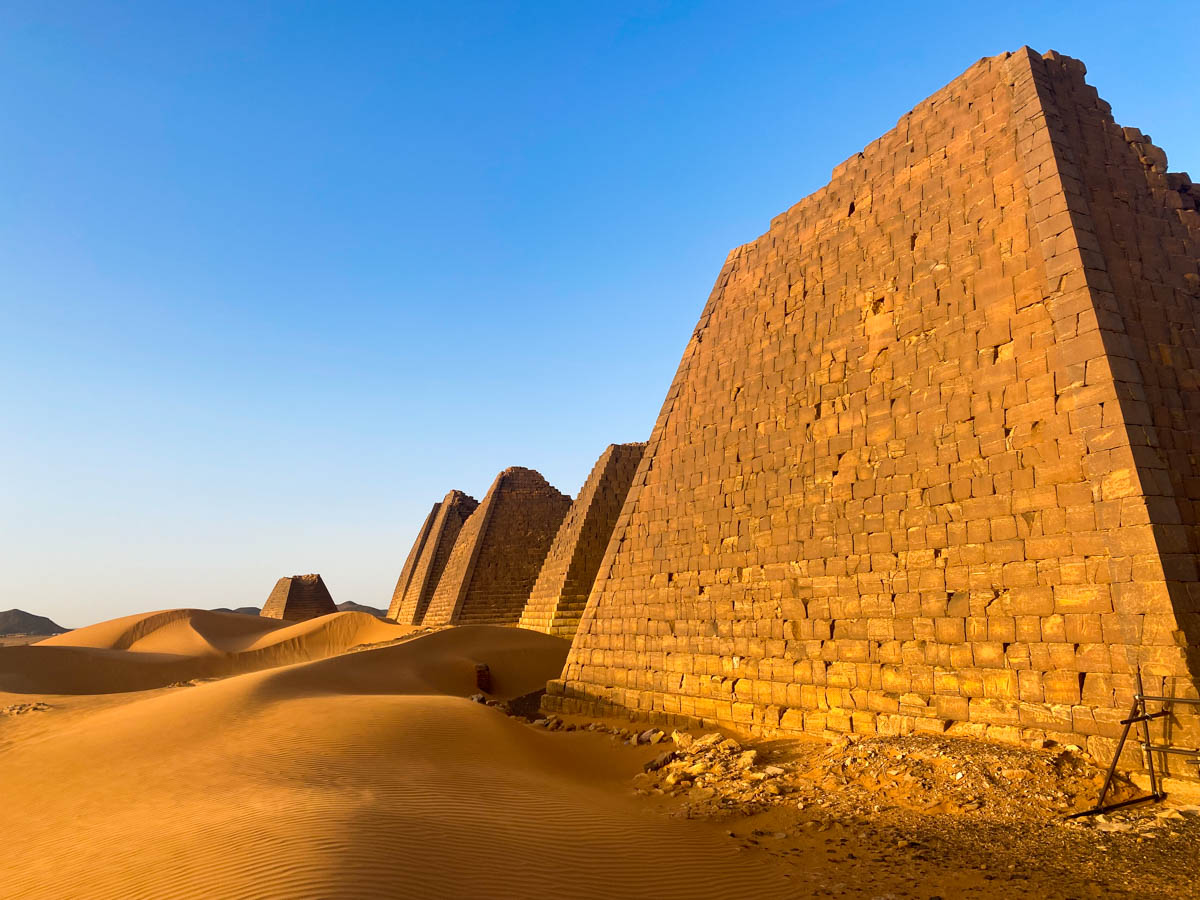
The copper hue of the drifting sand is almost as beautiful as the pyramids themselves.
Layout of the Meroe Pyramids and Directions
The main site is clearly marked on Maps.Me and Google Maps. This is actually the North Cemetery, although Google rather confusingly labels it as the East Necropolis. It’s about 1.5km to the east of the main road, and you can easily walk along the rough desert tracks to it (bring plenty of water).
Aside from the main site, there are other pyramids and tombs scattered throughout the desert. A second group is located a short distance to the west of the main road, at coordinates 16.932354, 33.728922 (here on Google Maps).

Sunset is a great time to experience the pyramids of Meroe.
Entrance Tickets to the Meroe Pyramids
The ticket price is officially $20 per person, but the ticket office is gradually being swallowed by sand from the desert and doesn’t appear to have been manned since the beginning of the pandemic.
When we were there, a local man approached us hawking souvenirs. When we didn’t buy any, he started asking us to buy tickets (which of course he didn’t actually have). In the end we gave him $10 for the two of us partly just to leave us in peace to watch the sunset and partly as a contribution to the local economy.
How to get to the Meroe Pyramids
The Meroe Pyramids are located in the desert off the main highway between Khartoum and Atbara. To get there independently, there are two options:
Public bus: Buses depart from both Khartoum and Atbara in the early mornings. Just tell your driver that you want to get off when you are near the Meroe Pyramids. You’ll probably have to buy a ticket for the full journey, which is around $10. From Shendi, there are minibuses heading north to Atbara. Again you’ll probably have to buy a ticket all the way to Atbara. I’m not sure of the price, but it should be around $5.
In Atbara, buses depart from the main bus station at 17.688227, 33.999192 (here on Google Maps). In Khartoum and Omdurman, you can buy a ticket from any bus ticket office and there are various pickup locations across the city.
Hitchhiking: Hitchhiking is generally easy in Sudan and, as this is the main road between Khartoum and both Atbara and Port Sudan, there is a lot of traffic, so finding a ride is easy. Many of our rides were on trucks and the drivers were always very friendly and helpful, although the trucks were very slow. Hitchhiking is an especially good option for getting back to one of the cities after visiting the Meroe Pyramids, as there are less buses in the evenings.

Can’t get enough of this beautiful place.

A few of the pyramids have been renovated so much that they appear to be made of concrete. Luckily only a few are like this though and they don’t detract from the beauty of the others.
What to see at Musawwarat es-Sufra
There are three interesting sites to visit at Musawwarat es-Sufra, all within a short walking distance of each other:
- The Great Enclosure
- The Apedemak (Lion Temple)
- The Great Hafir
The first two are ancient archaeological sites and form part of an ancient Meroitic temple complex built in the 3rd century BC. Detailed information about these sites can be found on the official Musawwarat es-Sufra archeological mission Website.
The Great Enclosure
No one is quite sure what the Great Enclosure was used for (hence the extremely generic name). However, there are many theories. One of the most interesting, based on the large number of statues of elephants it contains, is that it may have been an elephant training centre. Archeologists have also identified the remains of three probable temple sites within the complex.
The Great Enclosure is the largest of all the individual sites at Musawwarat es-Sufra and Naqa, at about 45,000 square metres. The main features are a series of pillars, the aforementioned statues of elephants and some intricate pharaonic-style carvings. There’s also a small museum in a shed at the back with a collection of statues and other artefacts from the site, protected by metal bars.

One of the beautifully carved elephant status at the Great Enclosure.

The little museum at the Great Enclosure.
The Apedemak (Lion Temple)
The Lion Temple is better preserved than the Great Enclosure and contains some beautiful reliefs featuring lions and elephants. It has been extensively renovated. Inside, there are some monolithic pillars and a sacrificial altar. The Lion Temple is surrounded by a fence, so to enter you will need to ask the locals to unlock the gate for you.
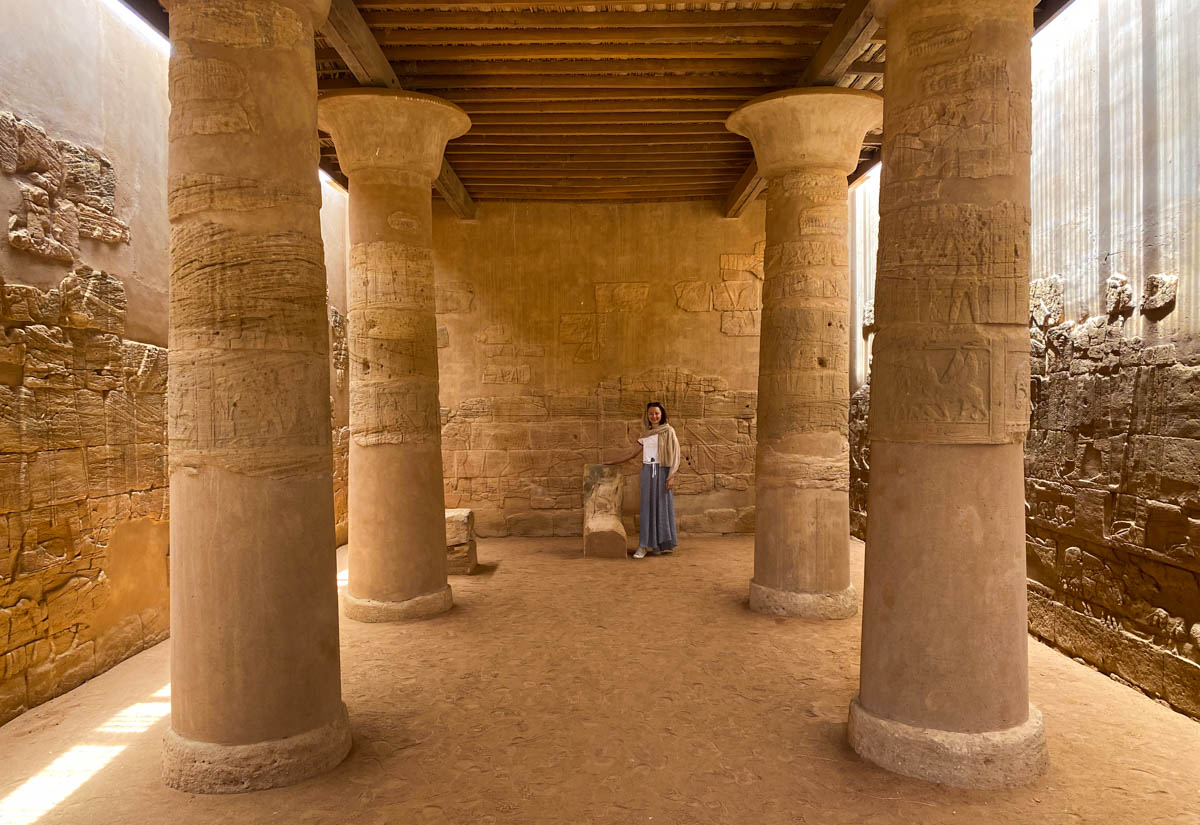
Anna contemplates who to sacrifice next at altar of the Apedemak, Musawwarat es-Sufra.

Two headless lions guard the entrance to the Apedemak, Musawwarat es-Sufra.
The Great Hafir (Great Reservoir)
The Great Hafir is often overlooked by travellers and I hadn’t come across it in my research before visiting. However, it was a definite highlight. The original reservoir was built around 2,500 years ago and was 150m wide and 15m deep. However, it’s since been expanded to 250m wide and the embankments that surround it are now 8m high.
The best thing about the Great Hafir is that it’s still in use today. When we were there, a group of locals were using it to water their herd of around thirty camels. They were extremely friendly and very happy for us to take photos of them and their herd. Our local driver and his friends told us that camels have little practical value in Sudan today, but are considered a status symbol. The owner of the herd must have been very rich (and presumably very proud) to have so many.
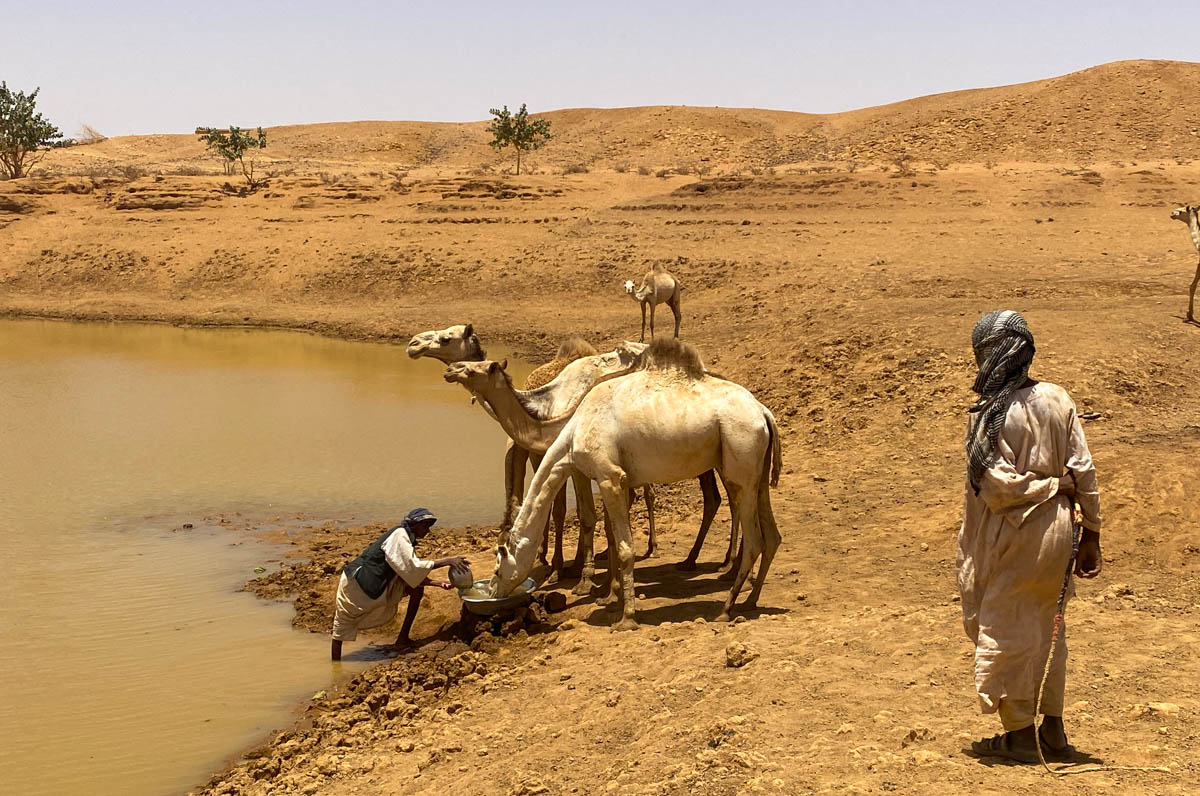
Local people still use the 2,500 year old Great Hafir to water their herds of camels.
Entrance Tickets for Musawwarat es-Sufra
There was no formal entrance ticket for Musawwarat es-Sufra when we were there. However, not long after we arrived, a group of locals turned up in a pickup and aggressively asked our local driver and his friends for money to be at the site. At one point it looked as though there could have been a physical altercation. However, after a lot of haggling, we agreed that we foreigners would pay $5 each (the locals enter for free).
The entrance fee is unofficial, but I think it’s fair enough that the locals want to receive something from tourists visiting a site in their area, especially given the obvious poverty in which they live. After we had paid, they became very friendly and unlocked the gate so that we could enter the Lion Temple. The camel herders also asked us for money, but we said we had already given money to one of the other locals, and they dropped the topic.
What to See at Naqa
There are four interesting sites to visit at Naqa, all within a short walking distance of each other:
- The Temple of Amun
- The Apedemak (Lion Temple)
- The Roman Kiosk
- A local well
The first three are ancient archaeological sites and form part of the ancient city of Naqa, an important trading post in the Kushitic Kingdom of Meroë. The final one is a modern addition to the list that we came across completely by accident and that turned out to be fascinating.
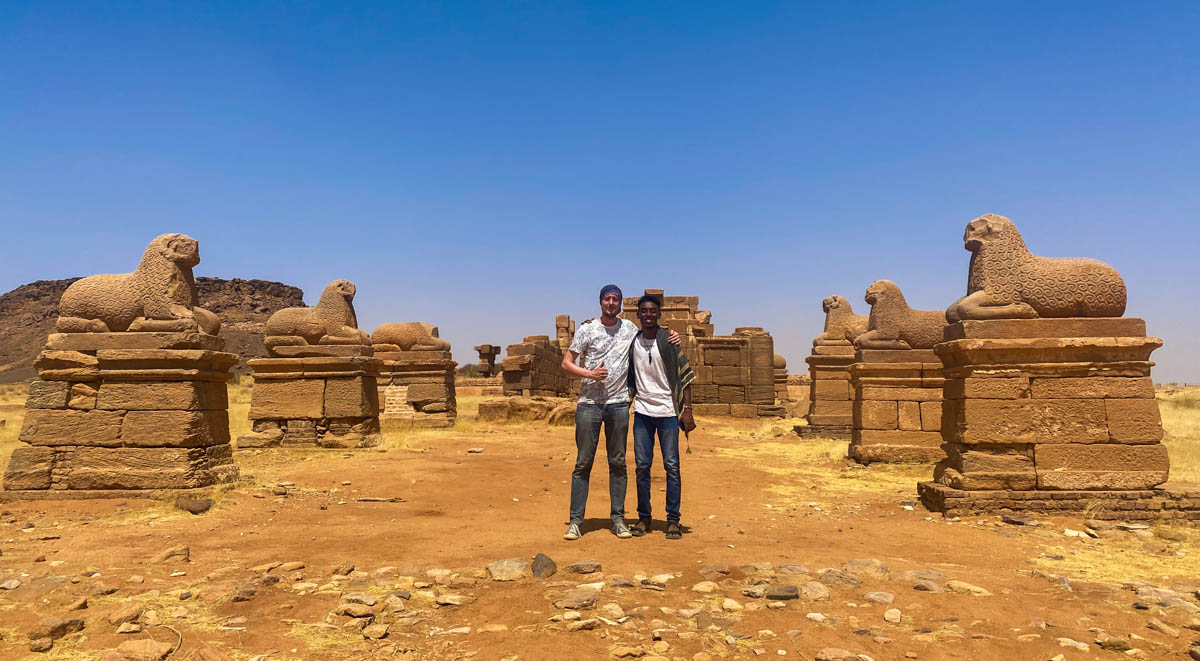
The rows of ram statues at the entrance to the Temple of Amun are the most impressive sight in Naqa.
The Temple of Amun
The Temple of Amun is an Egyptian-style temple built by King Natakamani around 2,000 years ago. The guy must’ve had quite an ego, because he also built several statues of himself. The most impressive part of this temple is the rows of ram statues that flank the entrance way.
The Apedemak (Lion Temple) and Roman Kiosk
The Lion Temple and Roman Kiosk sit together a couple of hundred metres from the Temple of Amun. The Lion Temple is built in the Kushite style and features some beautiful reliefs. The Roman Kiosk, which is also a temple, is interesting because the style is quite different from the other temples in the area. Although the entrance is Egyptian, the Corinthian columns and window arches are Roman.
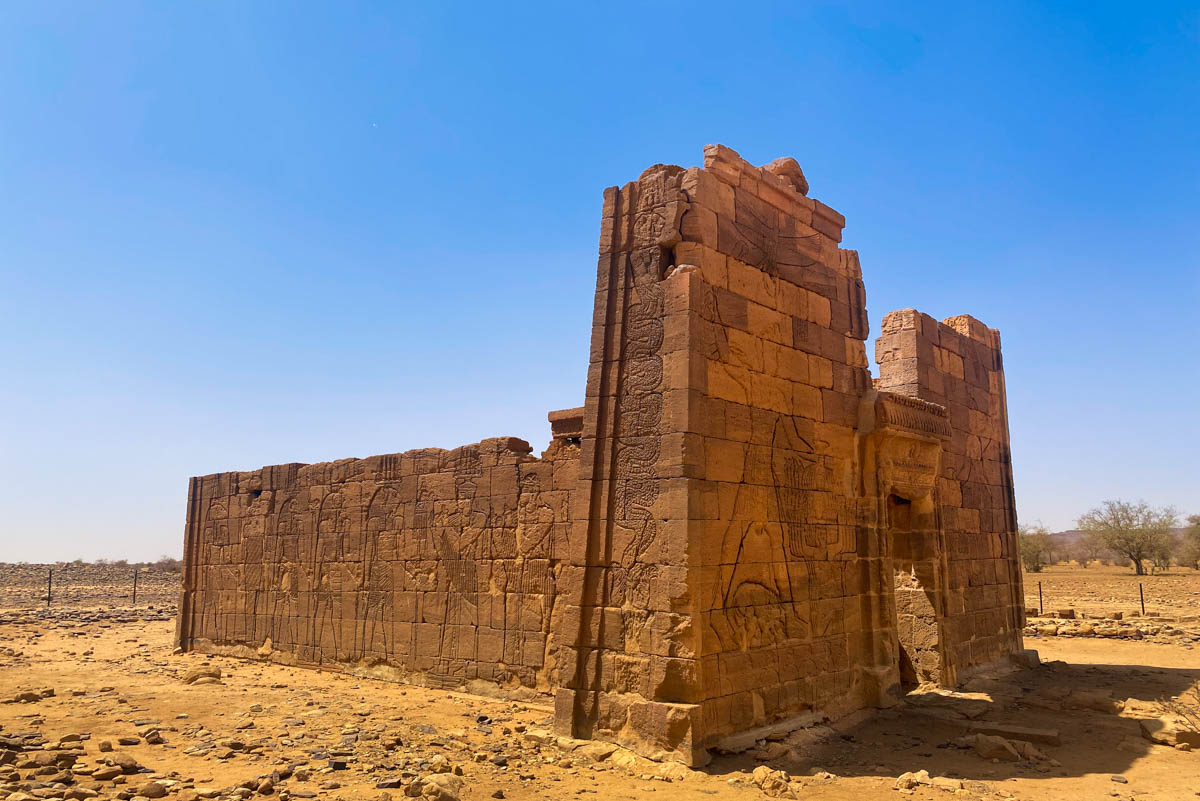
The reliefs of the Apedemak (Lion Temple) in Naqa are stunning and well-preserved.

The Roman Kiosk is a heady mix of architectural styles, but what really struck me about it is its unique cuboid shape.
The Local Well
Just next to the temples is a modern well used by locals to collect water. While this might seem a strange addition to the list of places to visit, for me it was a highlight, as it gives a glimpse into the everyday lives of local Sudanese people living in one of the harshest environments on earth.
When we were there, a group of local men were drawing water from the well using leather pouches. They lower the pouches down and then swing them back and forth a few times to fill them with water. As they’re now too heavy to pull back up by hand, donkeys are attached to the ends of the rope and made to walk away from the well to draw the pouches back up.
Be careful not to slip – the depth of the well is incredible. The donkeys walk almost 100m before the pouch reappears at the surface. Drawing water in this way is time consuming work, but at least it gives people access to fresh groundwater.
The well is located between the Temple of Amun and the Lion Temple at coordinates 16.269428, 33.273783 (here on Google Maps).

Local men raise water from the well while listening the radio in the 40 degree desert heat.
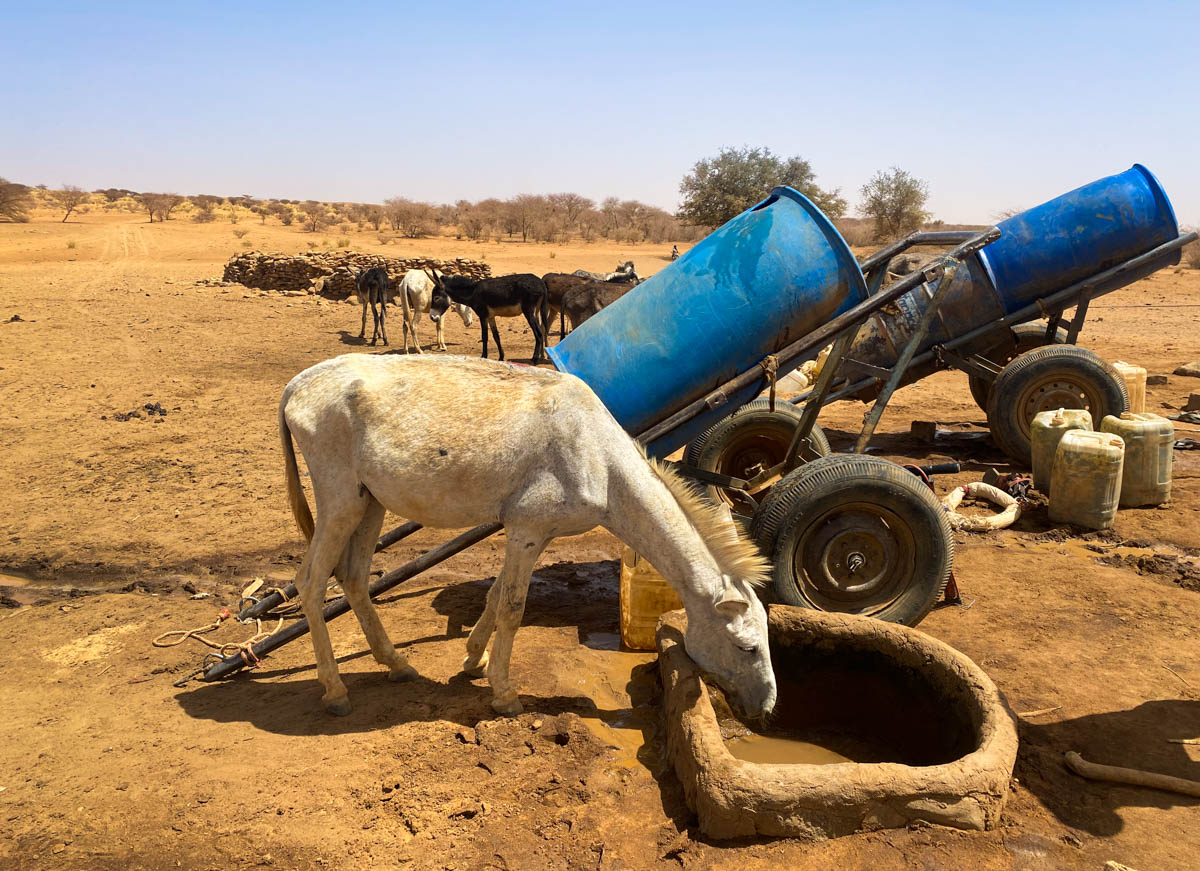
Donkeys are used to pull the water pouches from the deep well and to transport the water drums to where they’re needed.
Entrance Tickets for Naqa
There is a manned Police station at the entrance to the Naqa site and the Police mentioned the entrance fees when we arrived. However three Policemen wanted to travel to Shendi and didn’t have their own transport. We gave them a lift back when we left and the topic of the entrance fee was dropped. If you are asked for a fee, negotiate to a level that you are comfortable with (I usually aimed for $5 per person).
The Police also checked our passports and visas, so make sure you have these on you (as you always should in Sudan).
How to get to Naqa and Musawwarat es-Sufra
Naqa and Musawwarat es-Sufra are the most difficult places to travel to independently in Sudan, as they’re located about 30-40km off the main highway along desert roads with virtually no traffic. The roads are so rough that you really need a 4×4. I read about one backpacker who went with a local in a small car and ended up paying extra for repairs afterwards.
The most cost-effective way to visit these sites is by going to Shendi and asking around. We stayed at a very local hotel and got lucky, because a friend of the owners agreed to take us for $70. We thought this was expensive, but when we returned, it turned out there had been confusion between the hotel owners and the driver, who thought we were paying $140. He took the $70 as agreed, but said he couldn’t do the trip again at that price – the cost of fuel and repairs in Sudan is too high.
That said, try your luck by asking around. You might get lucky like we did. I wouldn’t try going there by hitchhiking, because there is practically no traffic on the desert roads and there’s a real risk of ending up stranded there. Even the cops at the small Police station in Naqa had no transport.
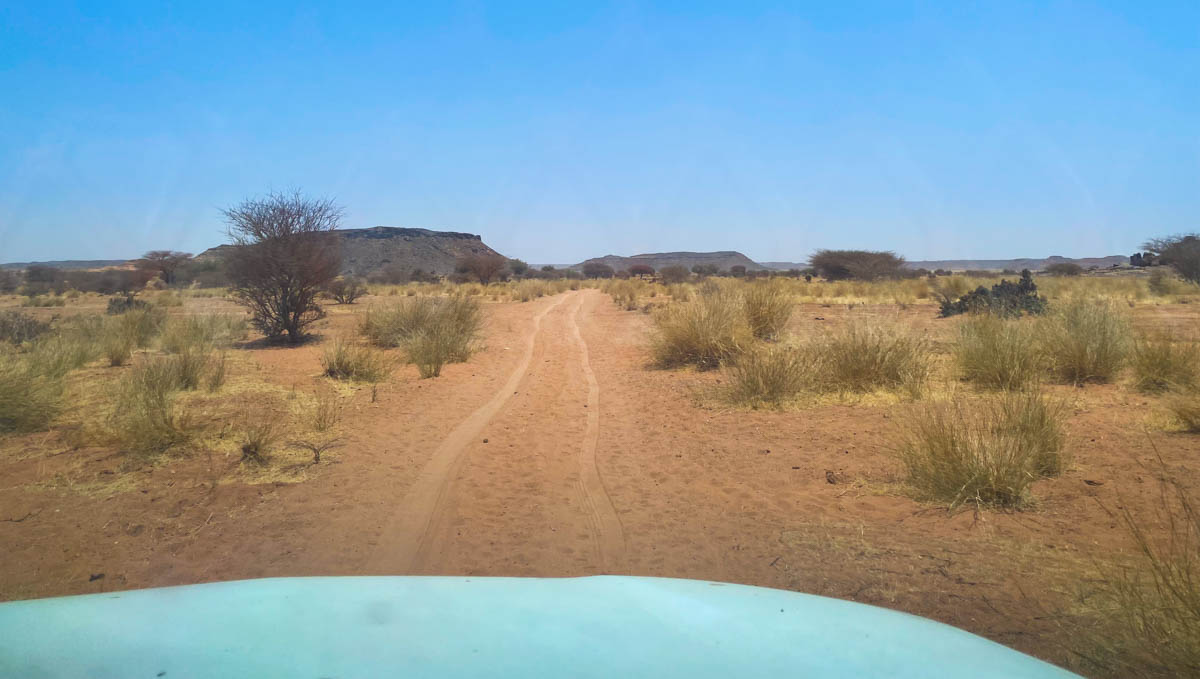
Part of the road to Musawwarat es-Sufra (and not one of the worst parts). A 4×4 is essential to reach these sites.
Suggested Itineraries
There are several possible itineraries for visiting the sights of the Meroe region. Here are the options I suggest.
Two-Day Itinerary
The sights in the Meroe region can be comfortably covered in two days. This is a relatively relaxed itinerary and will give you ample time at each site.
Day 1: Travel to the Meroe pyramids in the morning with plenty of food and water, spend the afternoon there and watch the sunset. In the evening, hitchhike to Shendi and spend the night there.
Day 2: Get up early in the morning and visit Naqa and Musawwarat es-Sufra by private vehicle.
The main challenge with this itinerary is that you’ll need to arrange transport to Naqa and Musawwarat es-Sufra on the evening of day 1 or morning of day 2. The easiest, but possibly most expensive, way to do this is through your hotel. If you get really stuck, the EI Kawther Hotel can arrange tours, but they’re likely to cost you an arm and a leg.
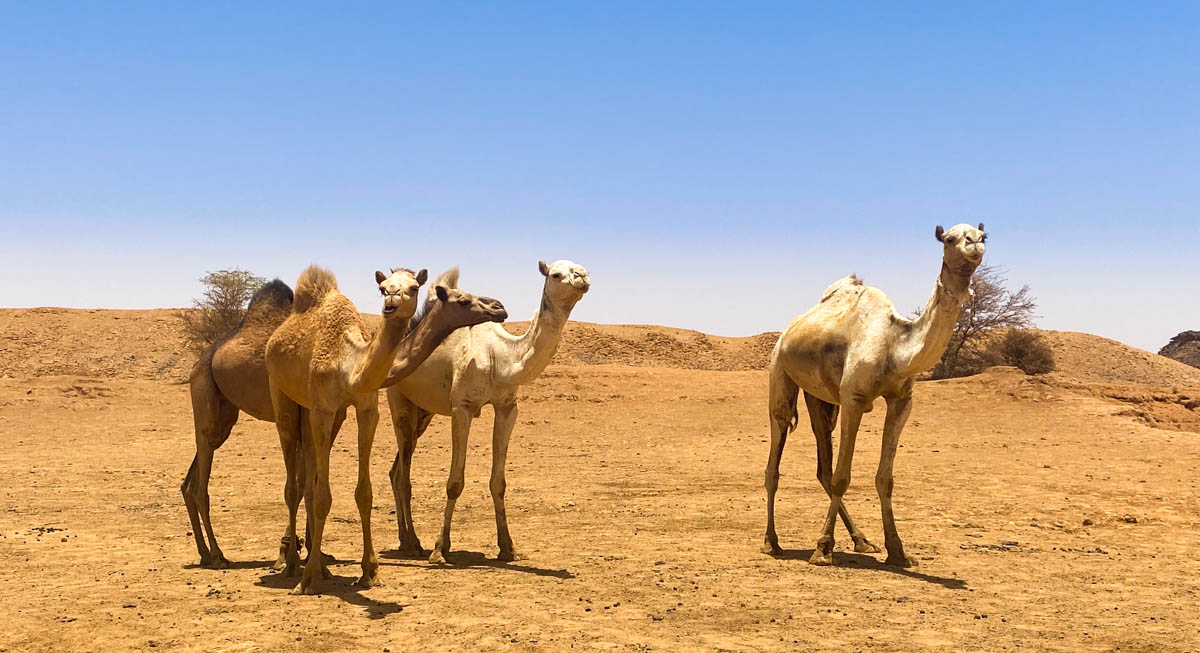
Few travellers visit the Great Hafir, which is a pity, because, let’s be honest, how could anyone resist these cuties?
One-Day Compressed Itinerary
If your time is constrained, it is possible to do both areas in one day. You’d need to arrive in Shendi the night before and stay overnight. Again, arrange transportation for Naqa and Musawwarat es-Sufra in the evening. You’ll need to depart early (around 8am should be okay) to spend the morning at the temples.
You’ll likely get back to Shendi around 2-3pm. Ask the driver to drop you on the edge of the main highway just before he turns off towards the town (a good location is 16.659629, 33.449481, here on Google Maps). You’re unlikely to find a bus at this time, but it’s not difficult to hitchhike the 45km from here to the Meroe Pyramids. After watching the sunset at the Meroe Pyramids, you can hitchhike either south to Khartoum or north to Atbara.
Meroe Pyramids Only Itinerary
Many people skip Naqa and Musawwarat es-Sufra either due to the expense of hiring a vehicle to get there or because they don’t want to deal with the hassle. In this case, you can do the Meroe Pyramids as a day trip from either Khartoum or Atbara.
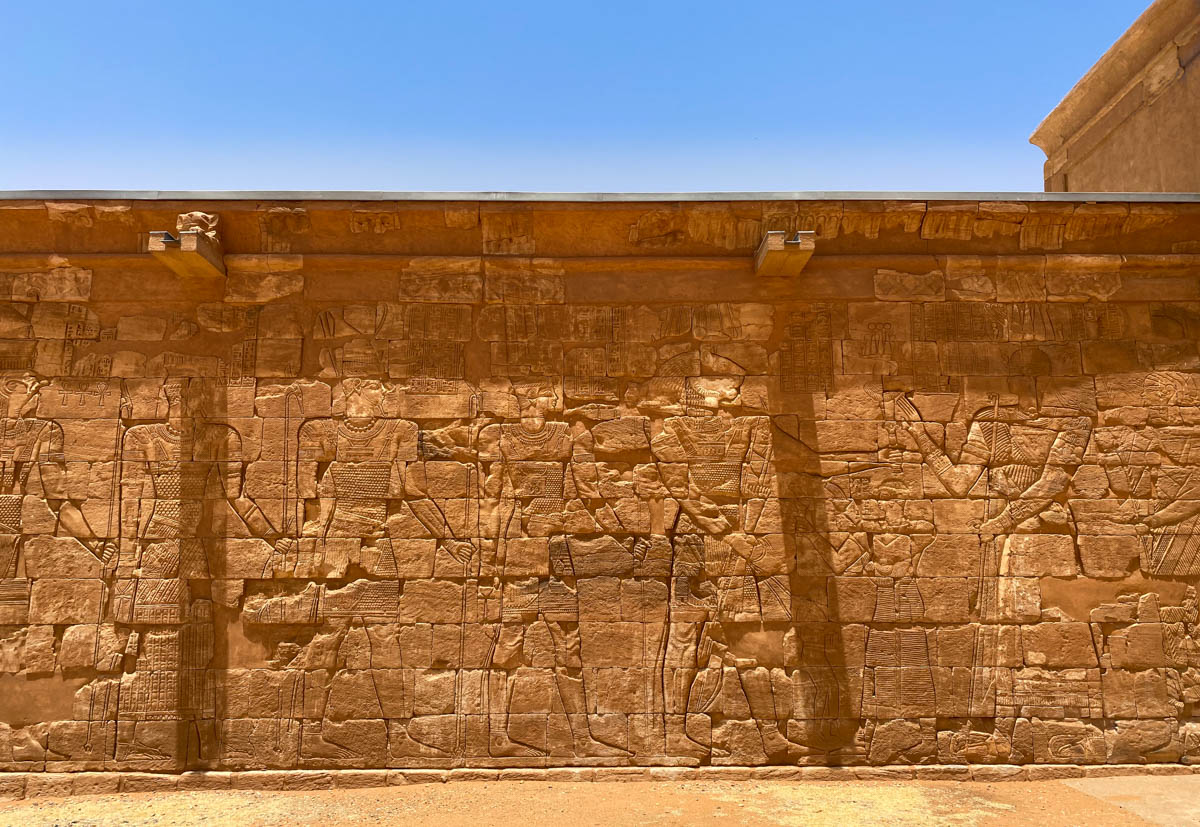
One of the beautiful reliefs at the Apedemak in Musawwarat es-Sufra.
Accommodation in the Meroe Area
The Meroe Pyramids are on the highway between Atbara and Shendi, so either is convenient for overnighting before or after your visit. For Naqa and Musawwarat es-Sufra, by far the nearest town is Shendi. Accommodation options are as follows:
Atbara: The two main areas for accommodation are near the market or near the bus terminal. We stayed near the bus terminal on our last day in the area, so that we could catch an early bus to Port Sudan the next day (most long-distance buses leave early in the morning). There are many hotels nearby and local people will be more than happy to tell you your options. We asked the bus ticket seller and he recommended several.
We stayed at a budget hotel called Apraa opposite the bus station. It was $14.50 for a double room, but I wouldn’t recommend it. It was dirty and there were bed bugs (our second encounter with the little beasts in Sudan).
Shendi: We stayed at a budget apartment hotel for $16.30. It was basic, but clean and didn’t have bed bugs, so it was fine for us. The location is at approximately 16.693951, 33.430328 (here on Google Maps). It’s on the second floor of a building that looks like an apartment building from the outside, but ask around on the street and someone will show you where to go.
A slightly more upmarket option, which we visited first but didn’t stay at, is the EI Kawther Hotel. This is a much more professional operation with prices to match. They also charge different rates to foreigners ($40 a night for a double room) and Sudanese ($18.10 per night).
Where to Eat in the Meroe Area
We were travelling during Ramadan, so food options were extremely limited, especially during the day. That said, during the evening we spent in Shendi, we did find one very nice outdoor eatery with meat and fresh juices. A meal for two was about $5 and fresh juices $1.40 each. Be very clear if you don’t want sugar in the juice, otherwise it will be very very sweet. The location is 16.693717, 33.429655 (here on Google Maps).
In Atbara, we ate at a local place, which was not bad but nothing special, near the bus station. The location is 17.689014, 33.997218 (here on Google Maps). However, there are more options around the main market.
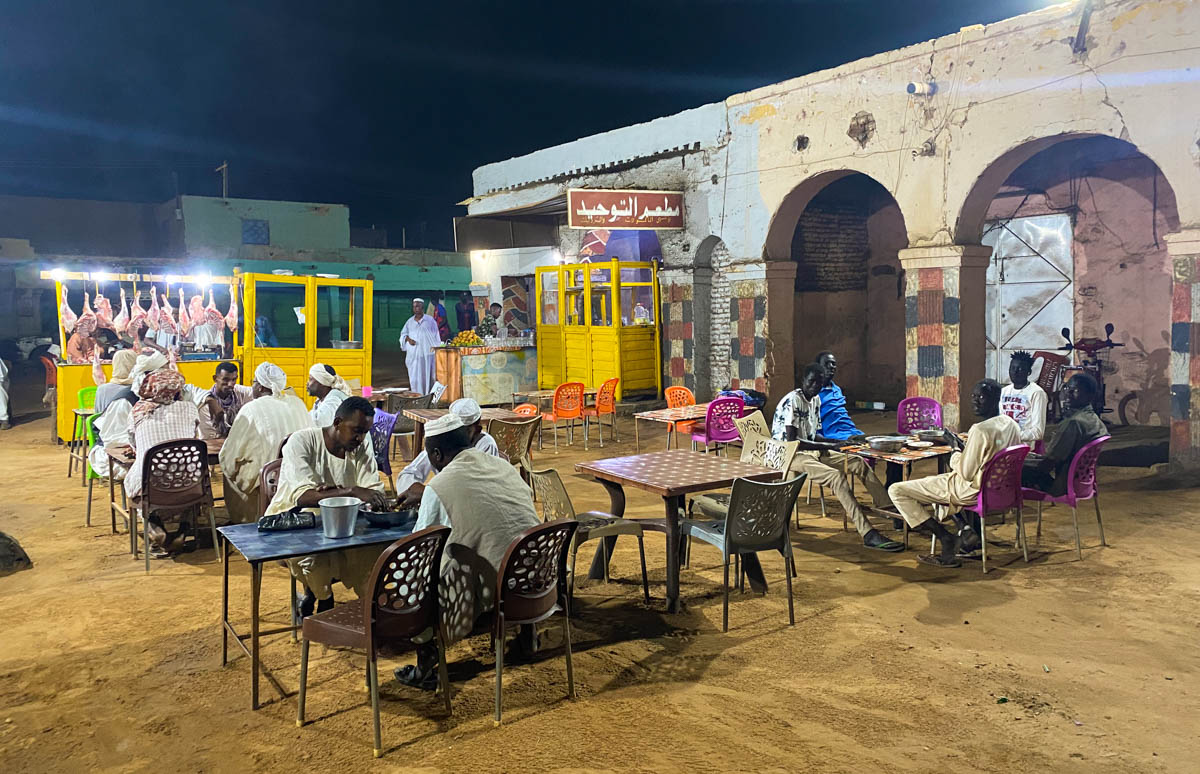
Great food and a great atmosphere at an outdoor restaurant in Shendi.
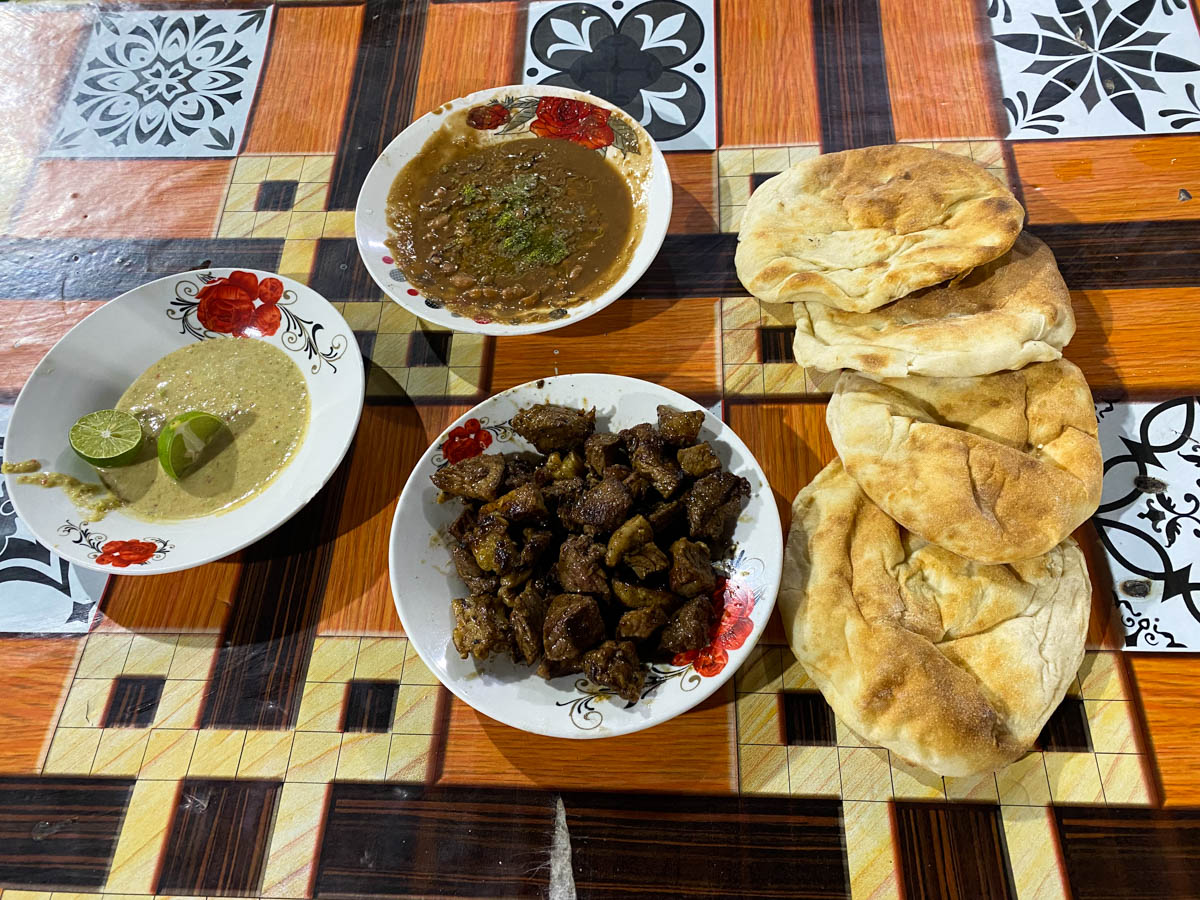
One of the best meals we had during our first week in Sudan. During Ramadan we didn’t even find restaurants in some Nubian villages, so this was amazing.
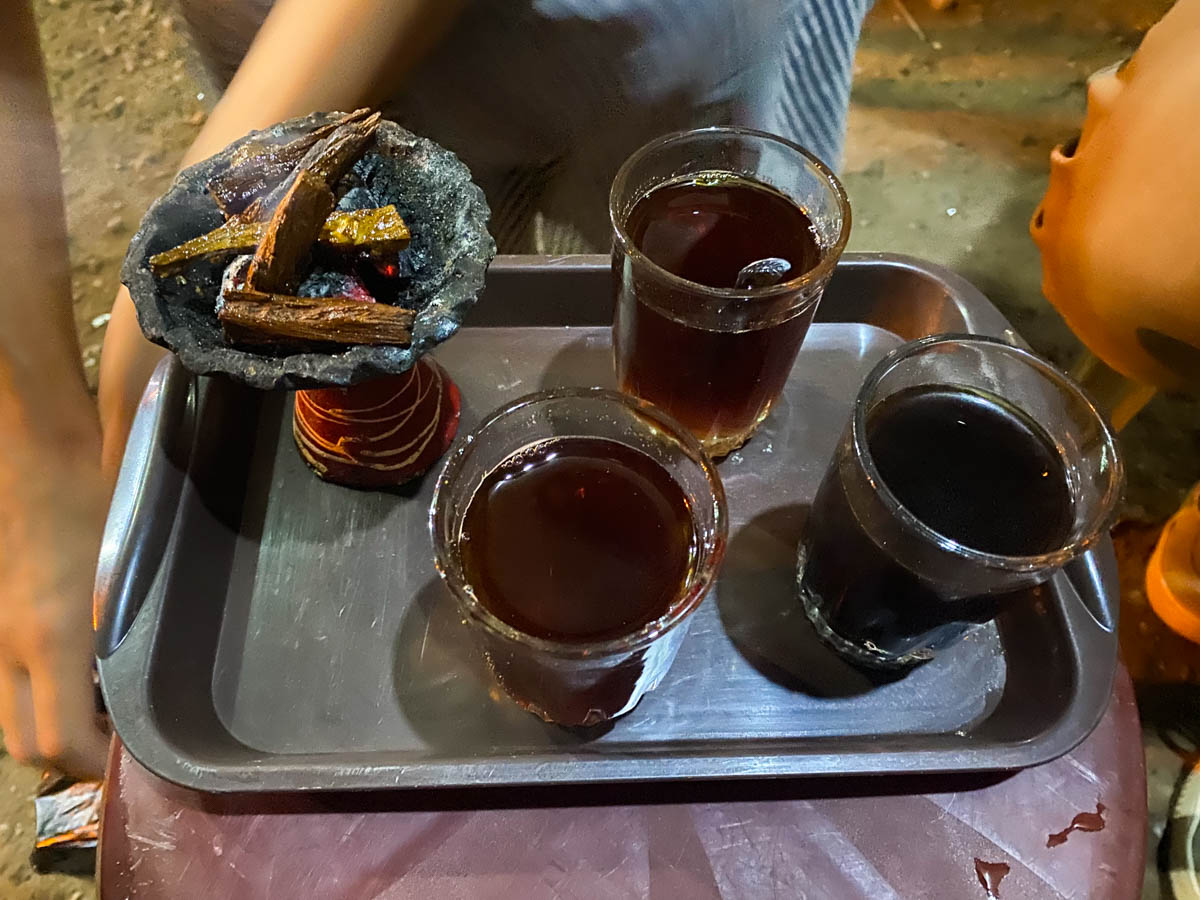
Tea is plentiful in Sudan and often served with a bowl of incense on the side to keep the mosquitoes at bay.
Safety in the Meroe Area
Most people say that Sudan is an extremely safe country, and generally it is. However, the economic situation is currently dire and many people have migrated to the cities in search of work, which they can’t necessarily find. Some people are desperate and it appears that crime has increased as a result.
The most serious incident we encountered happened to our friend from South Africa, who was trying to hitchhike from the outskirts of Atbara to Port Sudan at dusk. As it was Ramadan, when the sun set, most people stopped to eat iftar (the meal to break the daytime fast) and so the area where he was trying to hitch a ride was deserted. Five boys with machetes accosted him and stole his phone and wallet. They also tried to take his backpack (where his passport was), but luckily a truck driver saw what was happening and chased them away.
We also encountered some other more minor incidents:
- A young boy (probably early teens) in Shendi’s main market threw a piece of fruit at Anna. It hit her in the head, although not hard enough to cause serious injury.
- When I refused to give money to a child who was begging in Atbara near the bus station, he picked up a stone from the ground. As he raised his arm to throw it at me, a man intervened and stopped him.
- In the evening, from the hotel window, I saw some men bundling some other men into the back of a pickup. One of them was tied up and the other men repeatedly punched him.
I don’t think Sudan is a dangerous country, but exercise caution, especially around the Atbara/Shendi areas, and avoid walking around alone at night.

Chilling in the shade at the entrance to the Apedemak in Naqa.
More About Sudan
Sudan is a beautiful and unique country, but not the easiest place to travel. Check out my other Sudan guides for everything you need to know to backpack independently around this crazy country:
How to Visit Karima and the Barkal Pyramids
How to Visit Karima and the Barkal Pyramids Built in the shadow of the beautifully jagged Jabel Barkal mountain, Karima is one of the most interesting villages in Sudan. This backpacking travel guide contains everything you need to know to visit the village and its...
How to Visit Nubian Sudan: Abri and Kerma
Everything you need to know to visit Abri and Kerma Nubian villages in Sudan, including what to see, how to get there and where to stay.


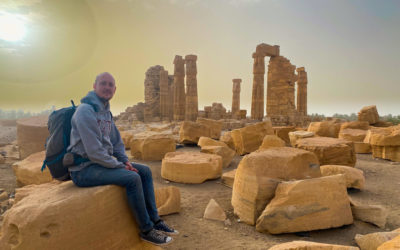
Recent Comments